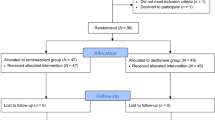Abstract
Background
It is unclear whether the sedative, analgesic or sympatholytic effects of adjunctive dexmedetomidine contribute to reduced analgesic requirements in general anesthesia. This study aimed to assess the analgesic effect of dexmedetomidine on intraoperative opioid requirements using body movement as observation indicator at similar BIS-guided sedative depth in propofol anesthesia.
Methods
Ninety patients were randomly divided into three groups to receive administration of saline, and dexmedetomidine at 0.5 and 1.0 µg kg−1 over 10 min, followed by saline and dexmedetomidine at infusion rates of 0.17 and 0.33 µg kg−1 h−1, respectively. After dexmedetomidine and saline bolus administration, propofol was titrated to maintain the BIS values at 45–55. When BIS values reached the predetermined range, remifentanil was administered by target-controlled infusion. Five minutes following remifentanil treatment, skin was incised and the motor response observed. Then, the concentration of remifentanil blunting the motor response in 50 % of patients (Ce50) was determined using a modified Dixon’s sequential ‘up-and-down’ method.
Results
Dexmedetomidine significantly decreased effect-site concentrations of propofol for maintaining the preset BIS range (P < 0.01). The Ce50 (95 % CI) of remifentanil were 0.93 (0.82–1.03), 1.03 (0.89–1.17) and 0.91 (0.77–1.06) ng ml−1 in the 0 (saline), 0.5 and 1.0 µg kg−1 dexmedetomidine groups, respectively, indicating non-statistically significant differences among groups (P > 0.0167).
Conclusions
Propofol and its combination with dexmedetomidine have similar opioid requirements for preventing motor response to skin incision when titrated to similar BIS values. These findings indicate that adjunctive dexmedetomidine for general anesthesia has sedative but no opioid sparing effects.





Similar content being viewed by others
References
Arcangeli A, D’Alò C, Gaspari R (2009) Dexmedetomidine use in general anaesthesia. Curr Drug Targets 10:687–695
Afonso J, Reis F (2012) Dexmedetomidine: current role in anesthesia and intensive care. Rev Bras Anestesiol 62:118–133
Grosu I, Lavand’homme P (2010) Use of dexmedetomidine for pain control. F1000 Med Rep 2:90
Gurbet A, Basagan-Mogol E, Turker G et al (2006) Intraoperative infusion of dexmedetomidine reduces perioperative analgesic requirements. Can J Anaesth 53:646–652
Al-Zaben KR, Qudaisat IY, Al-Ghanem SM et al (2010) Intraoperative administration of dexmedetomidine reduces the analgesic requirements for children undergoing hypospadius surgery. Eur J Anaesthesiol 27:247–252
Bekker A, Sturaitis M, Bloom M et al (2008) The effect of dexmedetomidine on perioperative hemodynamics in patients undergoing craniotomy. Anesth Analg 107:1340–1347
Schnabel A, Meyer-Frießem CH, Reichl SU et al (2013) Is intraoperative dexmedetomidine a new option for postoperative pain treatment? A meta-analysis of randomized controlled trials. Pain 154:1140–1149
Ohtani N, Yasui Y, Watanabe D et al (2011) Perioperative infusion of dexmedetomidine at a high dose reduces postoperative analgesic requirements: a randomized control trial. J Anesth 25:872–878
Maze M, Angst MS (2004) Dexmedetomidine and opioid interactions: defining the role of dexmedetomidine for intensive care unit sedation. Anesthesiology 101:1059–1061
Franken ND, van Oostrom H, Stienen PJ et al (2008) Evaluation of analgesic and sedative effects of continuous infusion of dexmedetomidine by measuring somatosensory- and auditory-evoked potentials in the rat. Vet Anaesth Analg 35:424–431
Sanders RD, Giombini M, Ma D et al (2005) Dexmedetomidine exerts dose-dependent age-independent antinociception but age-dependent hypnosis in Fischer rats. Anesth Analg 100:1295–1302
Kaul HL, Bharti N (2002) Monitoring depth of anaesthesia. Indian J Anaesth 46:323–332
Smith WD, Dutton RC, Smith NT (1996) Measuring the performance of anesthetic depth indicators. Anesthesiology 84:38–51
Johansen JW (2006) Update on bispectral index monitoring. Best Pract Res Clin Anaesthesiol 20:81–99
Struys MM, De Smet T, Depoorter B et al (2000) Comparison of plasma compartment versus two methods for effect compartment–controlled target-controlled infusion for propofol. Anesthesiology 92:399–406
Minto CF, Schnider TW, Egan TD et al (1997) Influence of age and gender on the pharmacokinetics and pharmacodynamics of remifentanil I. Model development. Anesthesiology 86:10–23
Minto CF, Schnider TW, Shafer SL (1997) Pharmacokinetics and pharmacodynamics of remifentanil II. Model application. Anesthesiology 86:24–33
Ebert TJ, Hall JE, Barney JA et al (2000) The effects of increasing plasma concentrations of dexmedetomidine in humans. Anesthesiology 93:382–394
Kauppila T, Kemppainen P, Tanila H et al (1991) Effect of systemic medetomidine, an alpha 2 adrenoceptor agonist, on experimental pain in humans. Anesthesiology 74:3–8
Angst MS, Ramaswamy B, Davies MF et al (2004) Comparative analgesic and mental effects of increasing plasma concentrations of dexmedetomidine and alfentanil in humans. Anesthesiology 101:744–752
Nelson LE, Lu J, Guo T et al (2003) The alpha2-adrenoceptor agonist dexmedetomidine converges on an endogenous sleep-promoting pathway to exert its sedative effects. Anesthesiology 98:428–436
Kasuya Y, Govinda R, Rauch S et al (2009) The correlation between bispectral index and observational sedation scale in volunteers sedated with dexmedetomidine and propofol. Anesth Analg 109:1811–1815
Chen Z, Shao DH, Hang LH (2013) Effects of dexmedetomidine on performance of bispectral index as an indicator of loss of consciousness during propofol administration. Swiss Med Wkly 143:w13762
Albertin A, Casati A, Federica L et al (2005) The effect-site concentration of remifentanil blunting cardiovascular responses to tracheal intubation and skin incision during bispectral index-guided propofol anesthesia. Anesth Analg 101:125–130
Frölich MA, Arabshahi A, Katholi C et al (2011) Hemodynamic characteristics of midazolam, propofol, and dexmedetomidine in healthy volunteers. J Clin Anesth 23:218–223
Wang T, Ge S, Xiong W et al (2013) Effects of different loading doses of dexmedetomidine on bispectral index under stepwise propofol target-controlled infusion. Pharmacology 91:1–6
Mertens MJ, Engbers FH, Burm AG et al (2003) Predictive performance of computer-controlled infusion of remifentanil during propofol/remifentanil anaesthesia. Br J Anaesth 90:132–141
Conflict of interest
No external funding and no competing interests declared.
Ethical standards
Approved by the Ethics Committee of the Affiliated People’s Hospital of Jiangsu University (SQ20130026). Registered at www.chictr.org (ChiCTR-TRC-13003216).
Author information
Authors and Affiliations
Corresponding author
Rights and permissions
About this article
Cite this article
Wu, X., Hang, LH., Chen, YF. et al. Remifentanil requirements for preventing motor response to skin incision in healthy women anesthetized with combinations of propofol and dexmedetomidine titrated to similar Bispectral Index (BIS) values. Ir J Med Sci 184, 805–811 (2015). https://doi.org/10.1007/s11845-014-1176-2
Received:
Accepted:
Published:
Issue Date:
DOI: https://doi.org/10.1007/s11845-014-1176-2




